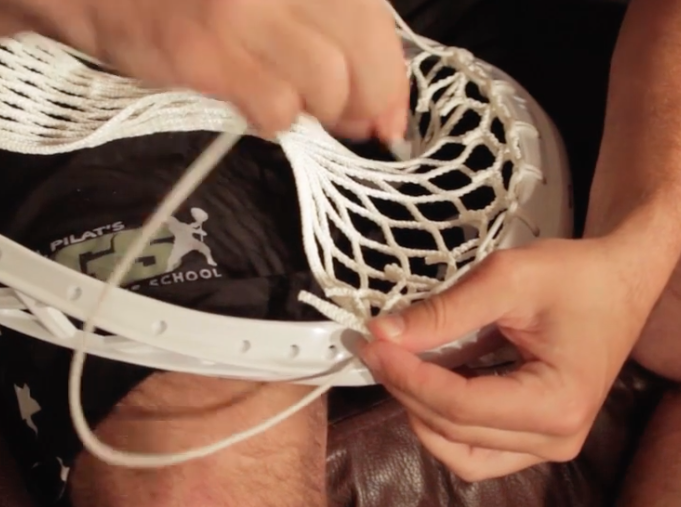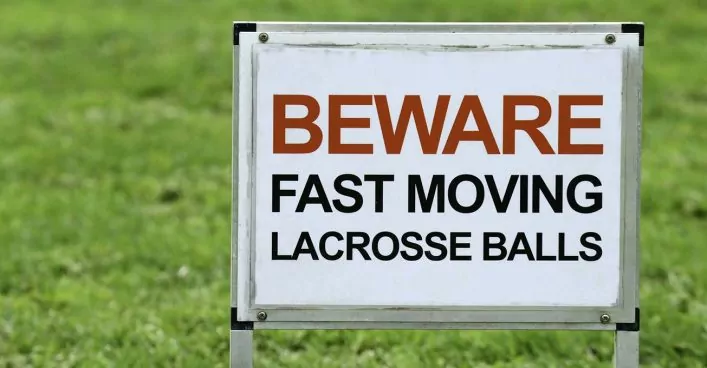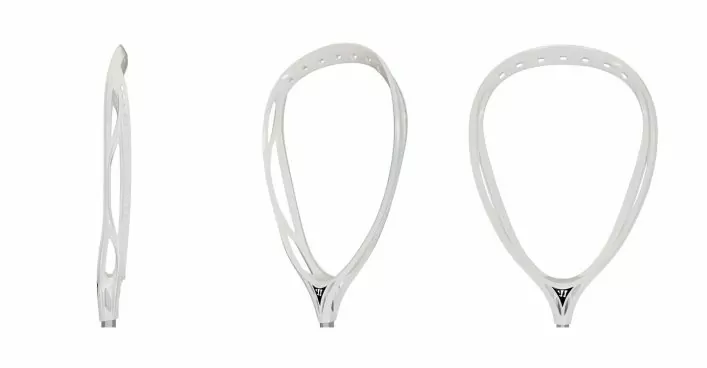A goalie’s stick is his or her weapon.
You’ve invested time, money, and lots of effort to get your stick exactly the way you want it and the now the thing is throwing absolute dimes.
So why let that go to waste?
Unlike the other lacrosse goalie equipment that we use, our sticks are the most fragile.
A helmet or chest protector won’t be ruined after a practice in the rain or mud, but your stick certainly can be.
Follow the advice in this article to ensure that your weapon of saves is in peak condition every time to step into the goal.
When you first string up a goalie stick with new mesh it needs to be broken in.
The mesh is stiff and is very likely to give up a lot of rebounds.
Our save technique can help reduce the chance of a rebound but we’re much better off with broken in mesh.
To break in the mesh – use it. It isn’t rocket science.
Pound it with your fist. Pound it with a ball. Play wall ball. Take shots. Anything to get that mesh worked in.
STX even sells an item that will help you pound the pocket, aptly named the Pocket Pounder:
I’ve heard stories of goalies using products like fabric softener, hair conditioner or shaving cream to speed up the process of breaking in their mesh however I tend to stick with the traditional methods.
Just work that pocket until its broken in.
The first basic rule of caring for your goalie stick is to treat it with respect.
Respect means not leaving your gear lying on top of the stick where the weight could mess up the mesh or plastic.
When not in use, your stick should be kept leaning against a wall with the mesh pushed out.
Respect means not letting your friends play with your stick.
They don’t know the time and effort you’ve put into creating a perfect pocket. They could accidentally alter the way it throws or worse yet, break the stick.
Even if they don’t break the stick, the extra wear and tear they put on your stick will certainly shorten its life.
Respect means storing your stick in a room temperature environment instead of a freezing cold garage. The bitter cold can make the plastic brittle and very susceptible to breaking when its hit by a hard shot.
Heat and humidity also has the same effect on the plastic so be sure you’re storing your stick in a room temperature environment, especially during the off-season when you’re more likely to be working out in the gym than on the lacrosse field.
Another tip is don’t hang your stick on the wall via a nail. The pressure on the mesh causes a premature rip and you’ll have to restring your goalie head.
And finally respect means basic common sense. Care for your stick and you’ll have one less thing to worry about when the other team’s offense is ripping shots at you.

It is ideal to have a backup stick.
When I played I had an identical stick setup (STX Eclipse with 12 Diamond Mesh) that I used as a backup stick. While my game stick used the Warrior Kryptolite shaft, my backup used an inexpensive aluminum shaft.
I’ve since upgraded to the STX Eclipse 2 and now use the OG Eclipse as my backup wand.
I would rotate use between my primary and my backup stick during the practices so each stick remained well broken in and each pocket threw exactly the way that I wanted.
If there was a practice that occurred during a rainy day, I’d always use my backup stick while my gamer rested on the sideline upright with a plastic bag covering the head.
I even know many goalies who even have a 3rd stick that they only use during rainy days. Unfortunately, most goalies can’t afford this luxury. You’ll be fine with a primary and a backup stick.
If you can’t afford a backup stick but have a backup goalie on the team, spend some time during practice familiarizing yourself with one another’s sticks. That way in an emergency you’ll be able to use the backup keeper’s stick.
There are no rainouts in lacrosse. We play in all conditions and unfortunately for our sticks, some of those conditions include mud, rain, and snow.
The way you care for your stick after the game can mean the difference in ensuring it’s not ruined the next time you take the field.
The important thing to know is that wet lacrosse mesh on your goalie head will dry in the same form you left it.
Here are the steps to follow after a rainy game or practice –
- Clean off any excess mud right away – Use a hose to clean off dirt and mud from the head and pocket. It’s even ok to use soap to ensure all the mud is off. Since the mesh is already wet before we start the drying process we want to ensure there’s no mud or dirt remaining on the stick.
- Fill pocket with newspapers or an absorbent towel – Crumple up a bunch of single sheets of newspaper and stuff them into the pocket of your stick. The paper will help absorb the water. In place of newspapers, you could also use a small towel.
- Pound the pocket with your glove or hand to reform the pocket.
- Store the stick overnight with a heavy lacrosse ball and the newspapers in the pocket.
- After the stick dries, the mesh will stiffen so be sure to pound the pocket again and throw with it to re-break it in.
After a game or practice it’s so easy to toss your stick in the corner or leave it in the car but good goalie stick maintenance requires putting in some work to ensure your baby is well-taken care of and continues to perform.

You don’t want to be dependent on another player or another coach to string up a goalie head.
By learning how to string your own goalie head you can also be in control. As you get better at this skill, you can customize the string job to match exactly how you like to play.
Also by learning how to string your own head you become familiar with how to make small adjustments to help your game.
If your stick is not throwing correctly, you’ll know how to adjust the shooting strings to fix it. If the pocket is giving up too many rebounds, you’ll know how to adjust the sidewall strings to tighten the top and loosen the bottom.
If a string breaks, you’ll know how to fix it rather than completely giving up on the string job.
Goalie string jobs also loosen up with time as fast shots will stretch out the strings and pocket so you’ll need to know how to give the stick tune-ups from time to time.
Learning how to string your own goalie stick is well worth the investment in time if you plan on being a goalie.
If you don’t know how to string a stick you can start with my illustrated guide to stringing a goalie head. There are also embedded videos in that post if you’d rather learn via video.
The lacrosse goalie stick is the single most important piece of equipment when it comes to making saves.
The other gear is also important but more so to protect us, not necessarily to make the save.
So as goalie we spend a lot of time ensuring our stick is just right. Why let all that time go to waste by not caring for your goalie stick?
Follow the tips in this article to ensure your save machine is always operating at the highest level.
Until next time! Coach Damon
Do you have any other lacrosse goalie stick maintenance tips? I’d love to hear them. Please let me know in the comments.








 14 Amazing Lacrosse Goalie DrillsAug. 1, 2024
14 Amazing Lacrosse Goalie DrillsAug. 1, 2024 Quick Guide To Lacrosse Slang TermsApril 14, 2025
Quick Guide To Lacrosse Slang TermsApril 14, 2025 Lacrosse Goalies Rules To KnowJune 28, 2022
Lacrosse Goalies Rules To KnowJune 28, 2022 Lacrosse Goalie Step-by-Step Guide to Getting RecruitedFebruary 6, 2022
Lacrosse Goalie Step-by-Step Guide to Getting RecruitedFebruary 6, 2022 18 Lacrosse Goalie Drills to Improve Your GameApril 24, 2025
18 Lacrosse Goalie Drills to Improve Your GameApril 24, 2025 7 Elements of a Great Lacrosse Goalie StanceAug. 1, 2020
7 Elements of a Great Lacrosse Goalie StanceAug. 1, 2020 12 Lacrosse Goalie Tips To Take Your Game to the Next LevelSeptember 10, 2024
12 Lacrosse Goalie Tips To Take Your Game to the Next LevelSeptember 10, 2024 STX Eclipse 3 Goalie Head ReviewApril 24, 2025
STX Eclipse 3 Goalie Head ReviewApril 24, 2025 Lacrosse Goalie WorkoutAug. 12, 2019
Lacrosse Goalie WorkoutAug. 12, 2019 The Basics of Making a SaveJune 29, 2021
The Basics of Making a SaveJune 29, 2021


















































Great post, how do I get the tape off of the shaft?
Thanks Riley! Pull off as much tape by hand. Then use lighter fluid to clean off the residue. I’ve also seen warm/liquid coconut oil used to clean off the tape residue. That is a safer option, better smelling option.